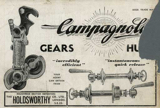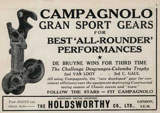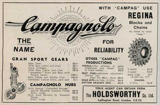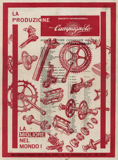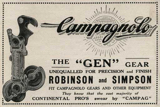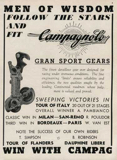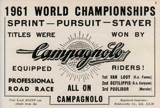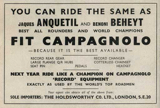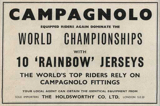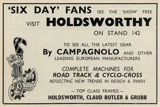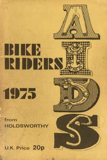Holdsworth - Aids to Happy Cycling 1949
Holdsworth - Aids to Happy Cycling 1949
- Publisher: Holdsworth
- Date: 1949
- Derailleur brands: Constrictor, Cyclo Gear Company, GB, Huret, Osgear, Resilion, Simplex, TriVelox
- Derailleurs: too many to mention
see also Sporting Cyclist 07/1958 - Holdsworth ad
see also Sporting Cyclist 07/1958 - Holdsworth ad
- Publisher: Sporting Cyclist
- Date: July 1958
- Derailleur brands: Campagnolo
- Derailleurs: Campagnolo Gran Sport
see also Sporting Cyclist 01/1959 - Holdsworth ad
see also Sporting Cyclist 01/1959 - Holdsworth ad
- Publisher: Sporting Cyclist
- Date: January 1959
- Derailleur brands: Campagnolo
- Derailleurs: Campagnolo Gran Sport
see also Sporting Cyclist 04/1959 - Holdsworth ad
see also Sporting Cyclist 04/1959 - Holdsworth ad
- Publisher: Sporting Cyclist
- Date: April 1959
- Derailleur brands: Campagnolo
- Derailleurs: Campagnolo Gran Sport
see also Sporting Cyclist 04/1960 - Holdsworth ad
see also Sporting Cyclist 04/1960 - Holdsworth ad
- Publisher: Sporting Cyclist
- Date: April 1960
- Derailleur brands: Campagnolo
- Derailleurs: Campagnolo Gran Sport
see also Sporting Cyclist 03/1961 - Holdsworth ad
see also Sporting Cyclist 03/1961 - Holdsworth ad
- Publisher: Sporting Cyclist
- Date: March 1961
- Derailleur brands: Campagnolo
- Derailleurs: Campagnolo Gran Sport
see also Sporting Cyclist 08/1961 - Holdsworth ad
see also Sporting Cyclist 08/1961 - Holdsworth ad
- Publisher: Sporting Cyclist
- Date: August 1961
- Derailleur brands: Campagnolo
- Derailleurs: Campagnolo Gran Sport
see also Sporting Cyclist 11/1961 - Holdsworth ad
see also Sporting Cyclist 11/1961 - Holdsworth ad
- Publisher: Sporting Cyclist
- Date: November 1961
- Derailleur brands: Campagnolo
- Derailleurs: none
see also Sporting Cyclist 01/1964 - Holdsworth ad
see also Sporting Cyclist 01/1964 - Holdsworth ad
- Publisher: Sporting Cyclist
- Date: January 1964
- Derailleur brands: Campagnolo
- Derailleurs: Campagnolo Record
see also Sporting Cyclist 11/1964 - Holdsworth ad
see also Sporting Cyclist 11/1964 - Holdsworth ad
- Publisher: Sporting Cyclist
- Date: November 1964
- Derailleur brands: Campagnolo
- Derailleurs: none
see also Sporting Cyclist 10/1967 - Holdsworth ad
see also Sporting Cyclist 10/1967 - Holdsworth ad
- Publisher: Sporting Cyclist
- Date: October 1967
- Derailleur brands: Campagnolo
- Derailleurs: Campagnolo Nuovo Record
Holdsworth - Bike Riders Aids 1975
Holdsworth - Bike Riders Aids 1975
- Publisher: Holdsworth
- Date: 1975
- Derailleur brands: Campagnolo, Cyclo Gear Company, GB, Huret, Regina, Simplex and Stronglight
- Derailleurs: too many to mention
W. F. (Sandy) Holdsworth opened a bike shop and frame building business in Putney, London in 1927. Gradually the business grew to include three operations, the retail shops in London, a bike manufacturing business that in addition to the Holdsworth brand used, at one time or another, the Freddie Grubb (from 1952), Claud Butler (from 1958) and MacLean (from 1962) brands, and a wholesaling business that became known as ‘Holdsworthy’.
The wholesaling business was built around a distinctive annual catalogue, which was originally called ‘Aids to Happy Cycling’ but, over the years, this became shortened to ‘Bike Riders Aids’. The Holdsworth(y) ‘Aids’ catalogues became sacred texts of the British cycling scene for two reasons:
- Firstly Holdsworth was careful to choose the very best of continental European cycling equipment. Unlike many of its competitors, the company was less interested in exclusivity than in quality.
- Secondly the ‘Aids’ catalogues were printed in a small format that comfortably fitted into the pocket of a cycling shirt or a saddlebag. Club cyclists could easily take one on a club run or on an evening jaunt down to a meeting at the club hut. It could then be used to inform the inevitable lively debate about equipment that always occurs whenever two or three are gathered together in the name of club cycling.
But these two factors were also to fuel the downfall of the Holdworthy wholesaling business. Holdsworth had focussed on club cyclists, and club cyclists are notoriously mean with their money (beyond any degree of rationality), and scornful of anyone who they see as being unnecessarily expensive (with scorn rapidly shading into visceral hatred). With the arrival of direct ‘grey’ imports from Europe, Holdworth’s prices came to be seen as outrageously greedy. Now even the portability of the catalogue became a fatal weakness - as the evidence of their avarice could be readily produced for all to see.
By the mid 1980s the ‘Aids’ catalogues had ceased to be - but for five decades starting in 1930 they provided an excellent annual snapshot of the state of the British market for quality bicycle components.

